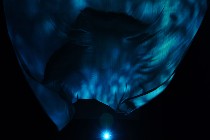 Liberating video was the hot theme that percolated through a panel discussion at the Fabric Workshop last night.
Liberating video was the hot theme that percolated through a panel discussion at the Fabric Workshop last night.
The discussion, which included most of the participants in the Fab’s “Surface Tension” show, drew a crowd of about 50 on a weekday night.
I was surprised to hear that video needed liberation–from the tv box and even from the movie screen. Clearly, I hadn’t thought enough about this issue, which formed the basis for the show curated by Cassandra Coblentz, who also moderated the panel along with video artist and Penn prof Joshua Moseley, a sharp cookie who asked intriguing questions without knowing the answers beforehand–very refreshing.
Panelist Peter Rose, whose theatrical video environment played with
screens, curtains and space (image above, “Pneumonal”), said liberating video from the tv box descends from the tradition of artists escaping the constraints of the rectangular canvas and its two-dimensional surface, and he brought up a number of video artists in that tradition including Bill Viola. He also said something about flat video being like Plato’s shadows on the cave wall.
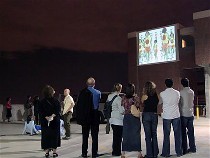 LURE‘s Aaron Igler, who took video screensavers onto a local rooftop (shown right), talked about liberating video from the gallery space. Later, he brought up the chilliness of technology, and how screensavers, no longer a technological necessity, were an antidote to the chill by allowing your familiar, personal image to welcome you back to your computer screen.
LURE‘s Aaron Igler, who took video screensavers onto a local rooftop (shown right), talked about liberating video from the gallery space. Later, he brought up the chilliness of technology, and how screensavers, no longer a technological necessity, were an antidote to the chill by allowing your familiar, personal image to welcome you back to your computer screen.
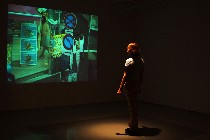 Camille Utterback, whose interactive video “Liquid Time” (shown left) got more intriguing to me as she talked about it, said that video technology enabled her screen to represent layers of images which responded to the depth of viewer’s bodies in motion.
Camille Utterback, whose interactive video “Liquid Time” (shown left) got more intriguing to me as she talked about it, said that video technology enabled her screen to represent layers of images which responded to the depth of viewer’s bodies in motion.
Earlier, she talked about the viewer role and location in front of the screen, but what interested me more was how bits of video data were stacked (by hypertext links, I guess) in conceptual three dimensions, allowing the flat screen to become an expression of virtual depth that reflects the real depth. What a concept.
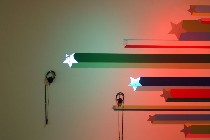 Nadia Hironaka turned out to be an old-fashioned girl, unapologetic and charming about the facts that her work required a flat screen for the most part and that it existed in time, with a beginning, middle and end.
Nadia Hironaka turned out to be an old-fashioned girl, unapologetic and charming about the facts that her work required a flat screen for the most part and that it existed in time, with a beginning, middle and end.
Even with a story arc, she didn’t mind people taking in just a part of the work. “Galleries have to assume that people won’t sit and watch your piece for two hours,” Hironaka said.
Did you know the average gallery video viewer spends six minutes in front of a video piece before bolting? Pete Rose, knowing this, made his piece loop every four minutes and provided a cushioned bench.
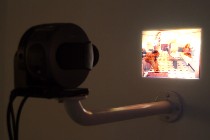 And speaking of time, the unanimous reason for using digitized video over analog was for timing and synchronizing effects . Nicole Cohen, who used two screens and two layers of video on each screen (shown, “Jet Lag”), was particularly concerned with synchronicity.
And speaking of time, the unanimous reason for using digitized video over analog was for timing and synchronizing effects . Nicole Cohen, who used two screens and two layers of video on each screen (shown, “Jet Lag”), was particularly concerned with synchronicity.
If you’ve read this far on your computer, you’re attention span may have hit overload–blogs and videos need time limits–so I’m stopping short and liberating you from this screen. The end.
photos: Aaron Igler









